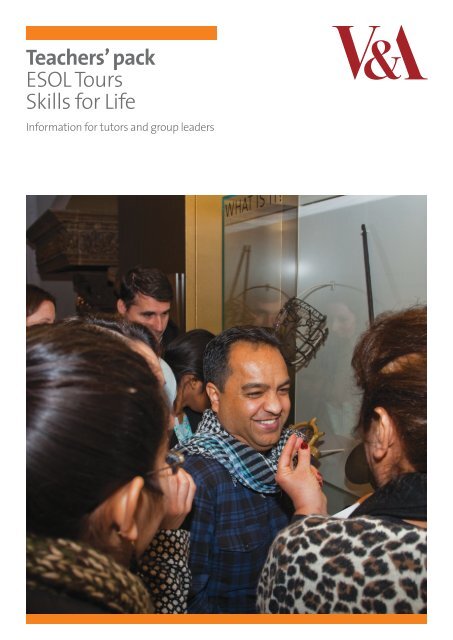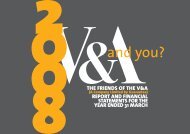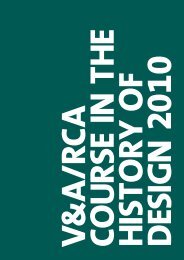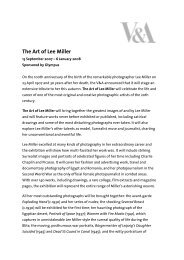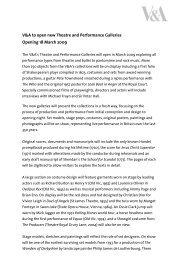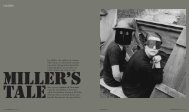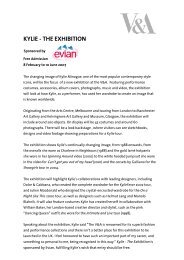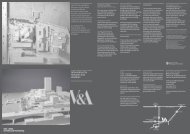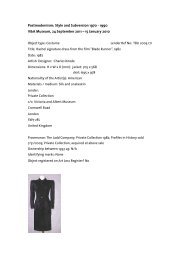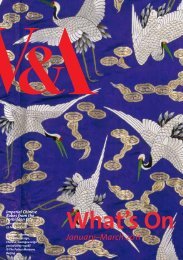Teachers' pack ESOL Tours Skills for Life - Victoria and Albert Museum
Teachers' pack ESOL Tours Skills for Life - Victoria and Albert Museum
Teachers' pack ESOL Tours Skills for Life - Victoria and Albert Museum
You also want an ePaper? Increase the reach of your titles
YUMPU automatically turns print PDFs into web optimized ePapers that Google loves.
Teachers’ <strong>pack</strong><br />
<strong>ESOL</strong> <strong>Tours</strong><br />
<strong>Skills</strong> <strong>for</strong> <strong>Life</strong><br />
In<strong>for</strong>mation <strong>for</strong> tutors <strong>and</strong> group leaders<br />
1
<strong>ESOL</strong> TEACHERS’ PACK<br />
Pre-visit<br />
in<strong>for</strong>mation<br />
Where is the V&A<br />
The V&A is on Cromwell Road in South Kensington, London SW7 2RL.<br />
<strong>Victoria</strong> <strong>and</strong> <strong>Albert</strong> <strong>Museum</strong>, © V&A, London<br />
For full in<strong>for</strong>mation on how to get to the V&A please visit the website:<br />
http://www.vam.ac.uk/content/visit-us/getting-here/<br />
How do I book a visit<br />
To book an <strong>ESOL</strong> or Citizenship Tour contact the Bookings Office:<br />
Phone: 020 7942 2211<br />
Email: bookings: office@vam.ac.uk<br />
Write to: Bookings Office, <strong>Victoria</strong> <strong>and</strong> <strong>Albert</strong> <strong>Museum</strong>, London SW7 2RL.<br />
Visits can be booked <strong>for</strong> any week day (10:00 – 16:00) <strong>and</strong> at other times by<br />
arrangement. We generally require two weeks notice.<br />
If you would like to bring a large number of students we can divide the group<br />
into two or more smaller groups.<br />
Support <strong>for</strong> people with disabilities is available on request.<br />
How much does the tour cost<br />
The tour is free of charge to publicly funded colleges <strong>and</strong> community<br />
organisations.<br />
Who is this tour <strong>for</strong><br />
The tour is <strong>for</strong> adult <strong>ESOL</strong> students on government-subsidised <strong>Skills</strong> <strong>for</strong> <strong>Life</strong><br />
courses studying the Adult <strong>ESOL</strong> Curriculum. <strong>ESOL</strong> tours are designed to<br />
encourage the use of core skills in Speaking <strong>and</strong> Listening, Reading <strong>and</strong><br />
Writing <strong>and</strong> offer students the opportunity to develop their language skills in a<br />
stimulating environment.<br />
The V&A also offers Citizenship tours which are designed to complement the<br />
Citizenship component of the <strong>ESOL</strong> curriculum <strong>and</strong> help prepare those students<br />
planning to take the <strong>Life</strong> in the UK Test. The aim of the tours is to increase<br />
students’ awareness of UK history <strong>and</strong> cultural diversity.<br />
Front cover: V&A <strong>ESOL</strong> tour, © V&A, London<br />
2
<strong>ESOL</strong> TEACHERS’ PACK<br />
Pre-visit<br />
in<strong>for</strong>mation (cont.)<br />
What happens after I book a visit<br />
After booking your tour, one of our V&A <strong>ESOL</strong> guides will contact you to find out<br />
more about your group’s language level <strong>and</strong> interests, <strong>and</strong> to discuss the visit<br />
with you.<br />
Your group can choose to visit two of the following galleries:<br />
British Galleries<br />
China<br />
Glass<br />
Japan<br />
Islamic Middle East<br />
Medieval & Renaissance<br />
South Asia<br />
What happens on the tour<br />
On the day of your visit, the V&A <strong>ESOL</strong> tutor will tell you briefly about the history<br />
of the V&A. They will then take the group on a tour of their two chosen galleries,<br />
answer questions <strong>and</strong> support students using worksheets.<br />
<strong>Tours</strong> last about two hours.<br />
How do I prepare my students <strong>for</strong> the visit<br />
Preparing your students <strong>for</strong> the visit will enhance their enjoyment <strong>and</strong> ensure<br />
that it is a meaningful learning experience that will support their language skills.<br />
We have prepared some pre-visit activities to do with your students in class<br />
be<strong>for</strong>e you visit the V&A. Please see pages 4 to 11.<br />
If you would like to know more about the V&A’s collections <strong>and</strong> programme of<br />
exhibitions <strong>and</strong> events, please visit: www.vam.ac.uk.<br />
Mosque lamp, probably Egypt, about 1630,<br />
museum no. 580-1875<br />
3
<strong>ESOL</strong> TEACHERS’ PACK<br />
Pre-visit<br />
activities<br />
V&A <strong>ESOL</strong> tour, © V&A, London<br />
Below are some suggested activities <strong>for</strong> discussion <strong>and</strong> some practical activities<br />
<strong>for</strong> the students to complete in class be<strong>for</strong>e your visit.<br />
Group discussions<br />
Discuss in advance with your students:<br />
Planning the visit<br />
1 Which galleries they would like to visit.<br />
2 Why people collect objects.<br />
3 How people are expected to behave in a museum – reasonable quietness,<br />
not touching exhibits unless indicated, not being allowed to carry large bags,<br />
security checks.<br />
4 What they will do on their visit – meet the guide, go on a tour of the chosen<br />
galleries, complete worksheets, have a cup of tea.<br />
What is a museum<br />
1 Have you visited a museum be<strong>for</strong>e Where<br />
2 Did you enjoy it What did you like about it<br />
3 What is a museum <strong>and</strong> what is in it (Exhibitions, displays, shop, cafés…)<br />
4 Who works in a museum<br />
5 What other things do museums do (Conservation, research, education...)<br />
6 Do you think museums are important<br />
You could discuss the following statements:<br />
What do you think a museum is<br />
• It is a place where beautiful <strong>and</strong> valuable works of art are kept.<br />
• A museum tells us about the history of a country.<br />
• It is a beautiful building with beautiful things inside.<br />
• It is like an encyclopaedia. It tells you about things you don’t know.<br />
• <strong>Museum</strong> displays help us to underst<strong>and</strong> our culture.<br />
• It is an exciting place. You can h<strong>and</strong>le objects <strong>and</strong> see how they are made or how they work.<br />
• <strong>Museum</strong>s take care of old things. <strong>Museum</strong>s show us things from other countries <strong>and</strong> help us<br />
to underst<strong>and</strong> other ways of life.<br />
4
<strong>ESOL</strong> TEACHERS’ PACK<br />
Group<br />
activities<br />
Planning your journey <strong>and</strong> finding in<strong>for</strong>mation about the V&A<br />
This activity involves group work, reporting back <strong>and</strong> question <strong>and</strong> answer<br />
sessions. Students choose the task they would like to do <strong>and</strong> divide up into<br />
two groups.<br />
Each group will:<br />
• collect in<strong>for</strong>mation<br />
• report back to the other group<br />
• be ready to answer any questions from the other group<br />
• prepare questions to ask the other group about their topic<br />
Group 1. Planning the journey<br />
This group could find in<strong>for</strong>mation on:<br />
• where the V&A is<br />
• possible bus routes <strong>and</strong> price/length of journey<br />
• the journey by tube – stations/lines/changes/price/length of journey<br />
Students could use an A-Z, V&A leaflets, the V&A website, bus <strong>and</strong> tube maps.<br />
Group 2. Finding out in<strong>for</strong>mation about the V&A<br />
This group could find out about:<br />
• opening <strong>and</strong> closing times<br />
• current exhibitions<br />
• what kind of objects the museum has<br />
• café facilities<br />
• entrance fees<br />
• shop<br />
Students could use printed in<strong>for</strong>mation about the V&A, or visit the website:<br />
www.vam.ac.uk/content/visit-us/opening-times/<br />
V&A <strong>ESOL</strong> tour, © V&A, London<br />
5
<strong>ESOL</strong> TEACHERS’ PACK<br />
<strong>Museum</strong><br />
vocabulary<br />
Looking at museum vocabulary in advance may be useful. The visit is a good<br />
chance to extend vocabulary to include words relating to objects on display.<br />
You could use these activities – adapted to the students’ oral <strong>and</strong> literary<br />
levels – to help students underst<strong>and</strong> words relating to objects, materials<br />
<strong>and</strong> techniques.<br />
1 The tutor brings in a collection of interesting objects<br />
2 Students h<strong>and</strong>le the objects<br />
3 The tutor teaches new adjectives relating to the objects<br />
4 Oral practice – students discuss the objects in pairs or with the whole<br />
group using:<br />
• true/false statements about the objects<br />
• questions which require yes/no answers<br />
• describing an object without naming it <strong>and</strong> other students find or draw it<br />
• students feeling an object in a bag <strong>and</strong> describing its shape <strong>and</strong> texture<br />
5 Literacy work – the tutor writes keywords on cards:<br />
• students match the cards to the objects<br />
• students write descriptions of the objects. Other students find/identify<br />
the object<br />
• students make a vocabulary book<br />
See Worksheets 2 <strong>and</strong> 3<br />
Tipu’s Tiger, mechanical organ, India, about 1793,<br />
museum no. 2545(IS)<br />
6
<strong>ESOL</strong> TEACHERS’ PACK<br />
Worksheets<br />
Practice in reading <strong>and</strong> comprehension<br />
1 The V&A <strong>and</strong> its history<br />
Worksheet 1 provides basic in<strong>for</strong>mation about the V&A<br />
<strong>and</strong> its history.<br />
You can adapt this to suit your students.<br />
2 <strong>Museum</strong> vocabulary (see Worksheet 2)<br />
3 Describing objects (see Worksheet 3)<br />
The Burghley Nef, salt cellar, France 1527-8<br />
museum no. m60-1959<br />
7
<strong>ESOL</strong> TEACHERS’ PACK<br />
Worksheet 1<br />
The V&A <strong>and</strong> its history<br />
The V&A is the UK’s national museum of art <strong>and</strong> design. It was founded by<br />
the British government after the Great Exhibition of 1851 which took place<br />
in London’s Hyde Park. It was named The South Kensington <strong>Museum</strong> in 1857.<br />
The government wanted designers, manufacturers <strong>and</strong> the public to learn<br />
about good design.<br />
In 1899 it was renamed The <strong>Victoria</strong> <strong>and</strong> <strong>Albert</strong> <strong>Museum</strong>, in honour of Queen<br />
<strong>Victoria</strong> <strong>and</strong> her husb<strong>and</strong> Prince <strong>Albert</strong>, who had been very much involved in<br />
The Great Exhibition.<br />
The main entrance is on Cromwell Road. It has figures of Queen <strong>Victoria</strong> <strong>and</strong><br />
Prince <strong>Albert</strong> above it.<br />
The V&A has almost 7 miles (11 kilometres) of galleries <strong>and</strong> more than 2 million<br />
objects from all over the world.<br />
<strong>Victoria</strong> <strong>and</strong> <strong>Albert</strong> <strong>Museum</strong>, © V&A, London<br />
Yes or No<br />
1 The <strong>Museum</strong> was started in 1858. Yes / No<br />
2 The V&A is in South Kensington now. Yes / No<br />
3 <strong>Victoria</strong> was Queen of Engl<strong>and</strong> in 1899. Yes / No<br />
4 The V&A building was founded by the<br />
British government.<br />
Yes / No<br />
5 The V&A building is small. Yes / No<br />
6 The V&A has a lot of objects<br />
from many different countries.<br />
Yes / No<br />
Now discuss these questions with another student:<br />
• Are there some museums in your country<br />
• Have you visited any museums be<strong>for</strong>e<br />
• What did you see in those museums<br />
• Did you enjoy these visits<br />
• What did you enjoy most about your visits<br />
If you would like to know more about the V&A <strong>and</strong> its history,<br />
visit www.vam.ac.uk/page/d/discover-the-v-<strong>and</strong>-a/<br />
8
<strong>ESOL</strong> TEACHERS’ PACK<br />
Worksheet 2<br />
<strong>Museum</strong> vocabulary – materials <strong>and</strong> techniques<br />
Look up <strong>and</strong> discuss the meaning of these words<br />
Metals<br />
bronze<br />
brass<br />
copper<br />
gold<br />
iron<br />
silver<br />
Fabrics<br />
brocade<br />
cotton<br />
linen<br />
silk<br />
velvet<br />
General<br />
gallery<br />
display<br />
case<br />
objects<br />
exhibition<br />
Ceramics<br />
china<br />
earthenware<br />
clay<br />
fritware<br />
porcelain<br />
stoneware<br />
terracotta<br />
glazed<br />
Other materials<br />
crystal<br />
fur<br />
ivory<br />
leather<br />
glass<br />
wood<br />
jade<br />
paper<br />
plastic<br />
Stone<br />
alabaster<br />
gemstone<br />
basalt<br />
granite<br />
limestone<br />
marble<br />
s<strong>and</strong>stone<br />
Processes<br />
carved<br />
embroidered<br />
enamelled<br />
lacquered<br />
woven<br />
glazed<br />
decorated<br />
inlaid<br />
painted<br />
V&A <strong>ESOL</strong> tour, © V&A, London<br />
9
<strong>ESOL</strong> TEACHERS’ PACK<br />
Worksheet 3<br />
Describing objects<br />
1 Function: it is used <strong>for</strong> / it was used <strong>for</strong> / it might be used as<br />
ornament / an ornament decoration furniture<br />
worship a garment a tool<br />
a container a memorial an implement<br />
a musical instrument<br />
2 Materials: it is made of<br />
glass plastic stone<br />
marble cloth ivory<br />
metal gold silver<br />
iron terracotta porcelain<br />
paper cardboard wax<br />
precious stones<br />
3 Size <strong>and</strong> shape<br />
round spherical rectangular<br />
square oval irregularly shaped<br />
box-like ball-shaped triangular<br />
bowl-like<br />
flat<br />
4 Colour <strong>and</strong> texture<br />
rough smooth glossy<br />
matt soft hard<br />
thick thin heavy<br />
light delicate sturdy<br />
transparent multicoloured light / dark<br />
10
<strong>ESOL</strong> TEACHERS’ PACK<br />
Worksheet 3<br />
Describing objects (cont.)<br />
Choose two objects <strong>and</strong> make notes on them in the table below:<br />
Name of object<br />
Name of object<br />
Function<br />
What was it used <strong>for</strong><br />
Materials<br />
What is it made of<br />
Size <strong>and</strong> shape<br />
What shapes do you see<br />
How big is it<br />
Colour <strong>and</strong> texture<br />
What colour is it<br />
What is its texture like<br />
11
<strong>ESOL</strong> TEACHERS’ PACK<br />
Activities after<br />
the visit<br />
Depending on students’ level, these could include:<br />
• Homework activities on the worksheets h<strong>and</strong>ed out on the tour.<br />
• Evaluation of the visit (see Appendix <strong>for</strong> evaluation <strong>for</strong>m).<br />
• Writing a thank you letter to the V&A <strong>ESOL</strong> guide, individually or<br />
as a group.<br />
• Looking at other worksheets <strong>and</strong> considering:<br />
1 Do students feel any differently now that they have spent some time in<br />
a large museum<br />
2 Do they still hold the same views<br />
3 Would they like to add anything they learnt to the statements discussed<br />
be<strong>for</strong>e the visit<br />
Students could also write a short essay, to discuss these arguments.<br />
The Ardabil Carpet, Iran, 1539–40,<br />
museum no. 272-1893<br />
12


